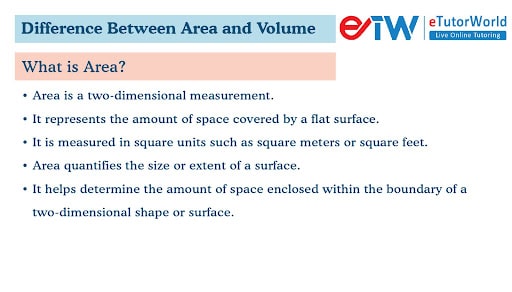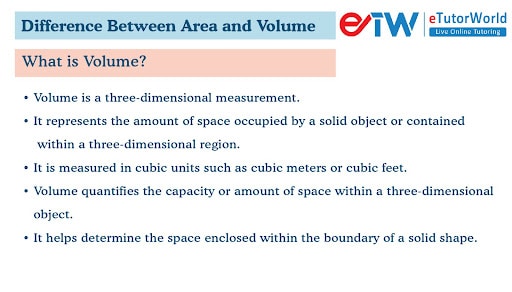Difference Between Area and Volume
Grade 7 Math Worksheets
Area is the measure of the space covered by a flat surface, while volume is the measure of the amount of space occupied by a solid object or region.
Table of Contents:
- What is Area?
- What is Volume?
- Difference Between Area and Volume
- Formulas for calculating the area of various shapes
- FAQs
Personalized Online Tutoring
Difference Between Area and Volume - Grade 7 Math Worksheet PDF
This is a free worksheet with practice problems and answers. You can also work on it online.
Sign up with your email ID to access this free worksheet.
"We really love eTutorWorld!"
"We really love etutorworld!. Anand S and Pooja are excellent math teachers and are quick to respond with requests to tutor on any math topic!" - Kieran Y (via TrustSpot.io)
"My daughter gets distracted easily"
"My daughter gets distracted very easily and Ms. Medini and other teachers were patient with her and redirected her back to the courses.
With the help of Etutorworld, my daughter has been now selected in the Gifted and Talented Program for the school district"
- Nivea Sharma (via TrustSpot.io)
Difference Between Area and Volume
The key difference between area and volume is that area is the measure of the space covered by a flat surface, while volume is the measure of the amount of space occupied by a solid object or region. Area is two-dimensional and measures the size of a surface, while volume is three-dimensional and measures the capacity or space inside an object.
What is Area?
Area measures how much space is covered or enclosed by a flat surface or shape. It tells us the size of a surface or the amount of space it occupies.
For example, if you have a rectangular garden, the area would tell you how much ground it covers. It is usually expressed in square units such as square meters or square feet. So, in essence, area helps us understand the extent or size of a two-dimensional surface.
What is Volume?
Volume is the measure of how much space an object or region occupies in three dimensions. It tells us the capacity or amount of space inside a solid object.
For example, if you have a box, the volume would tell you how much it can hold. It is usually expressed in cubic units such as cubic meters or cubic feet. So, volume helps us understand the amount of space that a three-dimensional object takes up or the space contained within a specific region.
What is the difference between Area and Volume?
Area:
- Area is a two-dimensional measurement.
- It represents the amount of space covered by a flat surface.
- It is measured in square units such as square meters or square feet.
- Area quantifies the size or extent of a surface.
- It helps determine the amount of space enclosed within the boundary of a two-dimensional shape or surface.
Volume:
- Volume is a three-dimensional measurement.
- It represents the amount of space occupied by a solid object or contained within a three-dimensional region.
- It is measured in cubic units such as cubic meters or cubic feet.
- Volume quantifies the capacity or amount of space within a three-dimensional object.
- It helps determine the space enclosed within the boundary of a solid shape.
“There have been times when we booked them last minute, but the teachers have been extremely well-prepared and the help desk at etutorworld is very prompt.
Our kid is doing much better with a higher score.”
7th Grade Tutoring
eTutorWorld offers Personalized Online Tutoring for Math, Science, English, and Standardised Tests.
Our Tutoring Packs start at just under $22.49 per hour, and come with a moneyback guarantee.
Schedule a FREE Trial Session, and experience quality tutoring for yourself. (No credit card required.)
Formulas for Calculating the Area of Various Shapes:
1. Rectangle:
Area = length × width
2. Square:
Area = side length × side length
3. Triangle:
Area = 0.5 × base × height
4. Circle:
Area = π × radius²
4. Parallelogram:
Area = base × height
5. Trapezoid:
Area = 0.5 × (base1 + base2) × height
6. Ellipse:
Area = π × major axis length × minor axis length
7. Regular Polygon:
Area = (perimeter × apothem) / 2
Formulas for Calculating the Volume of Various Shapes:
1. Cube:
Volume = side length × side length × side length
2. Rectangular Prism (or Cuboid):
Volume = length × width × height
3. Cylinder:
Volume = π × radius² × height
4. Sphere:
Volume = (4/3) × π × radius³
5. Cone:
Volume = (1/3) × π × radius² × height
6. Pyramid:
Volume = (1/3) × base area × height
7. Triangular Prism:
Volume = (1/2) × base × height × length
8. Ellipsoid:
Volume = (4/3) × π × radius1 × radius2 × radius3
Do You Stack Up Against the Best?
If you have 30 minutes, try our free diagnostics test and assess your skills.
Difference Between Area and Volume FAQS
What is the primary difference between area and volume?
The main difference is that area measures the size or extent of a two-dimensional surface, while volume measures the capacity or amount of space occupied by a three-dimensional object or region.
How are area and volume measured?
Area is measured in square units, such as square meters (m²) or square inches (in²), while volume is measured in cubic units, such as cubic meters (m³) or cubic inches (in³).
What does the area represent?
Area represents the amount of space covered by a flat surface or shape. It quantifies the size or extent of a two-dimensional region.
What does volume represent?
Volume represents the amount of space occupied by a solid object or contained within a three-dimensional region. It quantifies the capacity or space inside a three-dimensional shape.
Are area and volume dimensions the same?
No, they are different. Area is a two-dimensional measurement, while volume is a three-dimensional measurement.

Gloria Mathew writes on math topics for K-12. A trained writer and communicator, she makes math accessible and understandable to students at all levels. Her ability to explain complex math concepts with easy to understand examples helps students master math. LinkedIn
Affordable Tutoring Now Starts at Just $22.49
eTutorWorld offers affordable one-on-one live tutoring over the web for Grades K-12. We are also a leading provider of Test Prep help for Standardized Tests (SCAT, CogAT, MAP, SSAT, SAT, ACT, ISEE, and AP).
What makes eTutorWorld stand apart are: flexibility in lesson scheduling, quality of hand-picked tutors, assignment of tutors based on academic counseling and diagnostic tests of each student, and our 100% money-back guarantee.
Whether you have never tried personalized online tutoring before or are looking for better tutors and flexibility at an affordable price point, schedule a FREE TRIAL Session with us today.
*There is no purchase obligation or credit card requirement
Grade 7 Science Worksheets
- Elements and Compounds
- Solar Energy
- Photosynthesis
- Electricity and Magnetism
- Law of conservation of energy
- Periodic table
- Properties of Matter
- Waves
- Energy Resources
- Weather and Climate
- Immune, Circulatory and Digestive Systems
- Organs in Multi-cellular Organism
- Sedimentary, Igneous, and Metamorphic Rocks
- Structure of the Earth
- Law of Conservation of Mass
- Physical and Chemical Changes
- Scientific Method
- Human Digestive System
- Environmental Science
- Renewable and Non-renewable energy Resources
- Characteristics of Living Organisms
- Life Science
- Earth and Space Science
- Solar Eclipse
- Heat Technology
- Newton’s Laws of Motions
- Physical Science
- Tools, Measurement and SI Units
- Earth Atmosphere
- Interactions of Living things
- The Earth Ecosystem
- Organelles in Plant and Animal cells
- Layers of the Earth
- Cycles in Nature
Grade 7 Math Worksheets
- Fractions
- Linear equations word problems
- Statistics
- Properties of Parallel Line
- Finding slope from an equation
- Identifying Quadrilaterals
- Percent Change
- Properties of addition and multiplication
- Pythagorean Theorem
- Solving two step inequalities
- Symmetry
- Fractions to Decimals (New)
- Whole Number Exponents with Integer Bases (New)
- Adding and Subtracting Fractions (New)
- Integer Addition and Subtraction (New)
- Dividing Mixed Numbers (New)
- Basics of Coordinate Geometry (New)
IN THE NEWS

Our mission is to provide high quality online tutoring services, using state of the art Internet technology, to school students worldwide.
Online test prep and practice
SCAT
SSAT
ISEE
PSAT
SAT
ACT
AP Exam
Science Tutoring
Physics Tutoring
Chemistry Tutoring
Biology Tutoring
Math Tutoring
Pre-Algebra Tutoring
Algebra Tutoring
Pre Calculus Tutoring
Calculus Tutoring
Geometry Tutoring
Trigonometry Tutoring
Statistics Tutoring
Quick links
Free Worksheets
Fact sheet
Sales Partner Opportunities
Parents
Passive Fundraising
Virtual Fundraising
Our Expert Tutors
Safe and Secure Tutoring
Interactive Online Tutoring
After School Tutoring
Elementary School Tutoring
Middle School Tutoring
High School Tutoring
Home Work Help
Math Tutors New York City
Press
©2022 eTutorWorld Terms of use Privacy Policy Site by Little Red Bird
©2022 eTutorWorld
Terms of use
Privacy Policy
Site by Little Red Bird











